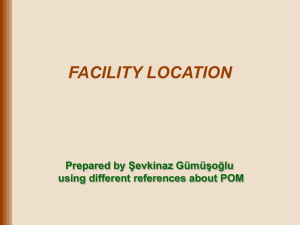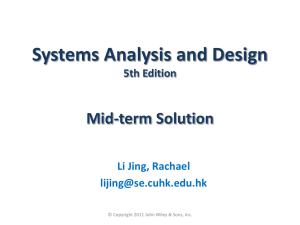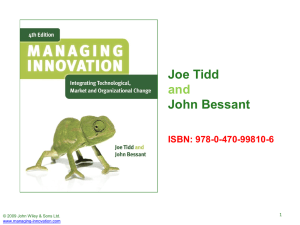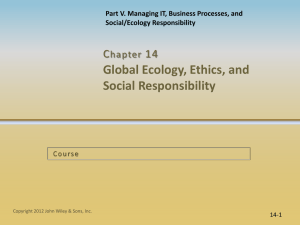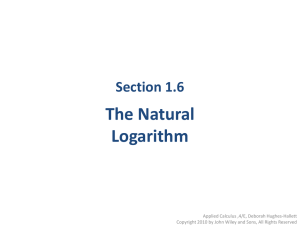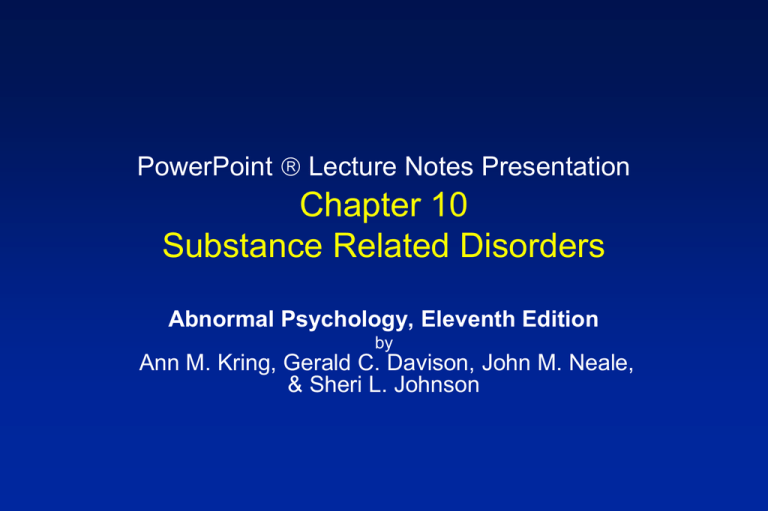
PowerPoint Lecture Notes Presentation
Chapter 10
Substance Related Disorders
Abnormal Psychology, Eleventh Edition
by
Ann M. Kring, Gerald C. Davison, John M. Neale,
& Sheri L. Johnson
Table 10.1 Percentage of US Population
Reporting Drug Use in Past Month (2006)
Copyright 2009 John Wiley & Sons, NY
2
Substance Dependence and Abuse
Substance dependence (addiction)
» Occupational or social problems, much time trying to obtain substance,
continued use despite problems, etc.
Involves either tolerance or withdrawal
» Tolerance
– Greater amounts required to produce desired effect
» Withdrawal
– Physiological and psychological consequences when individual
discontinues or reduces substance use
Restlessness, anxiety, cramps, death
Substance abuse
» Maladaptive use of substance
» No physiological dependence
In 2006, 22 million met criteria for dependence or abuse.
» Of those 15 million involved alcohol.
Copyright 2009 John Wiley & Sons, NY
3
Alcohol Dependence and Abuse
Alcohol abuse
» Negative social and occupational effects
» No tolerance, withdrawal, or compulsive usage
Alcohol Dependence
» More severe symptoms such as tolerance and withdrawal
» Withdrawal results in:
–
–
–
–
–
–
Anxiety
Depression
Weakness
Restlessness
Insomnia
Muscle tremors
Face, fingers, eyelids, other small musculature
– Elevated BP, pulse, temperature
Copyright 2009 John Wiley & Sons, NY
4
Alcohol Abuse and Dependence
Delirium tremens (DTs)
» Can occur when blood alcohol levels drop
suddenly
» Results in:
– Deliriousness
– Tremulousness
– Hallucinations
Primarily visual; may be tactile
2.5% of alcohol abusers develop
dependence
Copyright 2009 John Wiley & Sons, NY
5
Alcohol Abuse and Dependence
Polydrug abuse
» Many users abuse multiple substances
– e.g., cigarettes, cocaine, marijuana
– 85% of alcohol are smokers
Synergistic
» Some combinations of drugs produce stronger
reaction
– Alcohol and barbiturates
May cause death
– Alcohol and heroin
Alcohol reduces amount of heroin needed to produce lethal
dose
Copyright 2009 John Wiley & Sons, NY
6
Prevalence of Alcohol Abuse
Lifetime prevalence (Kessler et al., 1994)
» 20% for men
» 8% for women
Lifetime prevalence:
» Abuse - 17%
» Dependence – 12%
Binge drinking
» 5 drinks in short period
» 43.5% prevalence among college students
Heavy use drinking
» 5 drinks, 5 or more times in a 30 day period
– 17.6% prevalence among college students
Copyright 2009 John Wiley & Sons, NY
7
Prevalence of Alcohol Abuse
White adolescents and adults more likely to
abuse alcohol than African Americans
Binge & heavy use drinking lowest among Asian
Americans
Alcohol dependence highest among Native
Americans and Hispanics
21.3% of those with alcohol abuse or dependence
also have at least 1 mental disorder
» e.g. personality, mood, or anxiety disorders, or
schizophrenia
Copyright 2009 John Wiley & Sons, NY
8
Short-term Effects of Alcohol
Enters the bloodstream through small
intestine
» metabolized by the liver
Effects vary by concentration
» Concentration varies by gender, height, weight,
liver efficiency
Affects brain areas associated with error
monitoring and decision making.
Biphasic effect
» Initially stimulates
» Later depresses
– Increase in negative emotions
Copyright 2009 John Wiley & Sons, NY
9
Short-term Effects of Alcohol
Effect of ingesting large amounts
»
»
»
»
»
Impaired speech and vision
Interference in complex thought processes
Poor coordination
Loss of balance
Depression and withdrawal
Interacts with several neural systems
» Stimulates GABA receptors
» Increases dopamine and serotonin
» Inhibits glutamate receptors
Copyright 2009 John Wiley & Sons, NY
10
Long-term Effects of Alcohol
Malnutrition
» Calories from alcohol lack
nutrients
» Alcohol interferes with digestion
and absorption of vitamins from
food
Deficiency of B-complex
vitamins
» Amnestic syndrome
– Severe loss of memory for both
long and short term information
Cirrhosis of the liver
» Liver cells engorged with fat and
protein impeding functioning
» Cells die triggering scar tissue
which obstructs blood flow
» Liver disease and cirrhosis rank
12th in US causes of death.
Damage to endocrine glands
and pancreas
Heart failure
Erectile dysfunction
Hypertension
Stroke
Capillary hemorrhages
» Facial swelling and redness,
especially in nose
Destruction of brain cells
» Especially areas important to
memory
Copyright 2009 John Wiley & Sons, NY
11
Fetal Alcohol Syndrome
Heavy alcohol intake during pregnancy
» Fetal growth slowed
– Cranial, facial and limb anomalies occur
Moderate alcohol intake
» 1 drink per day
» Learning and memory impairments
» Growth deficits
Total abstinence recommended by NIAAA
Copyright 2009 John Wiley & Sons, NY
12
Nicotine and Cigarette Smoking
Nicotine
» Addicting agent of tobacco
» Principal alkaloid
– Active chemicals that give drugs their
physiological and psychological altering
properties
» Stimulates dopamine neurons in
mesolimbic area
– Involved in reinforcing effect
Copyright 2009 John Wiley & Sons, NY
13
Prevalence and Health
Consequences
About 440,000 Americans die prematurely
each year (USD-HHS, 2004)
Cigarettes kill 1,100 people every day
» 1 of 6 deaths related to tobacco use
Lung cancer is most common cancer
Cigarettes also cause or exacerbate:
» Emphysema, cancers of larynx, esophagus,
pancreas, bladder, cervix, stomach
» Sudden infant death syndrome and pregnancy
complications
» Cardiovascular disease
Copyright 2009 John Wiley & Sons, NY
14
Prevalence and Health
Consequences
Prevalence decreased since mid 1960s although use
increased through the 1990s, among white adolescents
More prevalent among white & Hispanic youth than African
Americans
» African Americans less likely to quit and more likely to get lung
cancer
– Metabolize nicotine more slowly
Chinese Americans have lower lung cancer rates
» Metabolize less nicotine
More prevalent among men than women
» Exception: 12 to 17 year olds
Secondhand smoke (ETS, environmental tobacco smoke)
» Higher levels of ammonia, carbon monoxide nicotine and tar
» Causes 40,000 deaths per year in US
Copyright 2009 John Wiley & Sons, NY
15
Marijuana
Drug derived from dried and ground
leaves and stems of the female hemp
plant (Cannibis sativa)
Hashish
» Stronger than marijuana
» Produced by drying the resin exudate of the
tops of plants
Copyright 2009 John Wiley & Sons, NY
16
Prevalence
Most frequently used
illicit drug in US
» 15,000,000 reported
using it in 2006
Heavier use in US
than in Europe,
African, or Canada
Peaked in 1979 then
began to decline
» Rose again in 90s
Greater use by men
than women although
rates among women
increased faster in
1990s
Copyright 2009 John Wiley & Sons, NY
17
Figure 10.2 Trends in Young Adults’ Use
in Previous Month from 2002 to 2006
Copyright 2009 John Wiley & Sons, NY
18
Effects of Marijuana
Major active ingredient
» THC (delta-9tetrahydrocannabinol)
Psychological
» Feelings of relaxation and
sociability
» Rapid shifts of emotion
» Interferes with attention,
memory, and thinking
– Decline in IQ over time
» Heavy doses can induce
hallucinations and panic
» Impairment of skills needed
for driving
Physiological
»
»
»
»
Bloodshot & itchy eyes
Dry mouth and throat
Increased appetite
Reduced pressure within the
eye
» Increased BP
» Abnormal heart rate
– May exacerbate preexisting
cardiovascular problems
» Damage to lung structure
and function in long term
users
– Impairment present for
several hours after ‘high’
has worn off
Copyright 2009 John Wiley & Sons, NY
19
Marijuana and the Brain
CB1 and CB2
» Two cannabinoid brain receptors
» High concentration in hippocampus
– Contributes to STM deficits
Increased blood flow to emotion regions
» Amygdala and anterior cingulate gyrus
Decreased blood flow to temporal lobe
» Associated with auditory attention
– Poor performance on listening tasks
Habitual use leads to tolerance
» Withdrawal symptoms also observed
Copyright 2009 John Wiley & Sons, NY
20
Therapeutic Effects of Marijuana
Reduces nausea and loss of appetite caused by
chemotherapy (Salan et al., 1975)
Relieves discomfort of AIDS (Sussman et al.,
1996)
Analgesic effects due to ability of THC to block
pain signals from reaching the brain.
Supreme Court rulings:
» Federal law prohibits dispensing marijuana for
medicinal purposes
» Medical use can be prohibited by federal
government even if states approve
Copyright 2009 John Wiley & Sons, NY
21
Opiates
Group of addictive sedatives that in moderate doses
relieve pain and induce sleep
»
»
»
»
Opium
Morphine
Heroin
Codeine
Synthetic sedatives
» Seconal and valium
Opiates legally prescribed as pain medications
include:
» Hydrocodone combined with other substances yields Vicodin,
Zydone, and Lortab
» Oxycodone the basis for OxyContin, Percodan, & Tylox.
Copyright 2009 John Wiley & Sons, NY
22
Prevalence of Opiate Use
Herion
» Estimated1,000,000 individuals addicted to heroin in US
– 300,000 in 2006 alone
» From 1995 to 2002, rates of use among adults 18 to 25
increased from 0.8% to 1.6%
» Accounted for 62 to 82% of drug-related hospital admissions
in Baltimore, Boston, & Newark.
Heroin is more pure (25 to 50%) than in the past
» Increases likelihood of overdose
OxyContin prescriptions jumped 1800% between
1996 and 2000 (DEA, 2001)
» 2.8 million users (SAMSHA, 2004)
– Can be dissolved for injection or snorting
– Street price from $25 to $40 per pill
Copyright 2009 John Wiley & Sons, NY
23
Psychological and Physical Effects of
Opiates
Euphoria, drowsiness, reverie, and lack of
coordination
» Loss of inhibition, increased self-confidence
» Severe letdown after about 4 to 6 hours
Heroin and OxyContin
» Rush
– Intense feelings of warmth and ecstasy following injection
Stimulate receptors of the body’s opioid system
» Endorphins and enkephalins
Tolerance develops and withdrawal occurs
» Muscle soreness and twitching, tearfulness, yawning
» Become more severe and also include cramps,
chills/sweating, increase in HR and BP, insomnia, & vomiting
– Withdrawal lasts about 72 hours
Copyright 2009 John Wiley & Sons, NY
24
Psychological and Physical Effects of
Opiates
29 year follow up of 500 heroin addicts (Hser,
et al., 1993)
» 28% dead by age 40
– Half by suicide, homicide, or accident
– One-third by overdose
Many users resort to illegal activities to obtain
money for drugs
» Theft, prostitution, dealing drugs
Exposure to infectious diseases via shared
needles
» e.g. HIV
» Evidence suggests that free needles reduces
infectious diseases associated with IV drug use
Copyright 2009 John Wiley & Sons, NY
25
Figure 10.3 ER Visits for Hydrocodone
and Oxycodone ODs
Copyright 2009 John Wiley & Sons, NY
26
Synthetic Sedatives
Barbituates
» Induce muscle relaxation,
reduce anxiety, produce mild
euphoria
» In 1940s prescribed to aid
sleep
» Usage declined from 1975
thru 1990s but increased
recently
Other synthetic sedatives
» Benzodiazepines
– e.g., Valium, Ketamine
Stimulate GABA system
Heavy dosages
» Slurred speech
» Unsteady gait
» Impaired judgment &
concentration
» Irritability & combativeness
» Accidental suffocation due to
excessive relaxation of
diaphragm muscles
Alcohol magnifies depressant
effects
Tolerance & withdrawal
» Delirium, convulsions & other
symptoms
Copyright 2009 John Wiley & Sons, NY
27
Stimulants: Amphetamines
Increase alertness and motor activity
Reduce fatigue
Amphetamines
» Synthetic stimulants
– Benzedrine, Dexedrine, Methedrine
» Trigger release of and block reuptake of norepinephrine and
dopamine
» Produce high levels of energy, sleeplessness
» Reduce appetite, increase HR, constrict blood vessels in skin
and mucous membranes
» High doses can lead to:
– Nervousness, agitation, irritability confusion, paranoia, hostility
» Tolerance can develop after only 6 days use (Comer et al.,
2001)
Copyright 2009 John Wiley & Sons, NY
28
Stimulants: Methamphetamine
Amphetamine derivative
(aka crystal meth)
» Can be taken orally,
intravenously, or
intranasally (snorting)
» In 2006, over 700,000
people used
methamphetamine
(SAMHSA, 2007).
Chronic use damages
brain
» Reduction in hippocampus
volume (see figure 10.4;
abusers represented by
yellow bars)
Copyright 2009 John Wiley & Sons, NY
29
Stimulants: Cocaine
Alkaloid obtained from coca leaves
»
»
»
»
Reduces pain
Produces euphoria
Heightens sexual desire
Increases self-confidence and indefatigability
Blocks reuptake of dopamine in mesolimbic areas of brain
Overdose
» Chills, nausea, insomnia, paranoia, hallucinations; possibly heart
attack & death
Not all users develop tolerance
» Some become more sensitive
– May increase risk of OD
In 2006, 2.4 million people over the age of 12 reported using
cocaine, and 700,000 reported using crack (SAMHSA, 2007).
Copyright 2009 John Wiley & Sons, NY
30
Stimulants: Cocaine
Crack
» Form of cocaine that quickly become
popular in the 80s
» Rock crystal that is heated, melted, &
smoked
» Cheaper than cocaine
Copyright 2009 John Wiley & Sons, NY
31
Hallucinogens, Ecstasy, and PCP
Hallucinogen effects include:
» Colorful visual hallucinations
» Synestesias
– Overflow from one sensory
modality to another
» Alterations in time
perception
» Lability of mood
» Anxiety & paranoia
LSD
» Extracted from mushroom
psilocybe mexicana
In 2006, there were about
100,000 users, down from 1
million in 2002
»
African Americans less likely to use
than others
Mescaline
» Active ingredient of peyote
Ecstasy
» Increase feelings of intimacy
and enhances mood
» Chemically similar to mescaline
and amphetamines
» Acts on serotonin
» Its use peaked in 2001, with 1.8
million users.
» d-lysergic acid diethylamide
Other hallucinogens
Psilocybin
PCP (phencyclidine)
» Angel dust
» Animal tranquilizer
» Causes severe paranoia and
violence
Copyright 2009 John Wiley & Sons, NY
32
Figure 10.5 Process of Becoming a
Drug Abuser
Copyright 2009 John Wiley & Sons, NY
33
Etiology of Substance-Related Disorders:
Developmental approach
Li et al. (2001) Two paths to alcohol abuse
1. First group began drinking in early adolescence,
increased drinking throughout high school
2. Second group drank lesser amounts in early
adolescence, increased drinking in middle school
and again in high school.
–
Boys more likely to be in the first group, girls in the
second group
Developmental studies do not account for all
cases
»
Not an inevitable progression through stages
Copyright 2009 John Wiley & Sons, NY
34
Etiology of Substance-Related Disorders:
Genetic Factors
Relatives and children of problem drinkers have higher-thanexpected rates of alcohol abuse or dependence
Greater concordance in MZ than DZ twins
» In men
– Alcohol, caffeine, smoking, marijuana, & drug abuse in general
» In women
– Role of genetics less clear
– Fewer available studies
– Findings are mixed
Genetic and shared environmental risk factors for illicit drug abuse
and dependence appear to be nonspecific
Ability to tolerate large quantities of alcohol may be an inherited
diathesis
» Asians have low rates of alcohol abuse
– Evidence for physiological intolerance in this group
CYP2A6
» Gene associated with metabolism of nicotine
» Smokers with defect in this gene less likely to become dependent (Rao
et al., 2000)
Copyright 2009 John Wiley & Sons, NY
35
Etiology of Substance-Related Disorders:
Neurobiological Factors
Nearly all drugs, including alcohol, stimulate the dopamine
system in the brain
Some evidence that people dependent on drugs or alcohol have
a deficiency in the dopamine receptor DRD2
People take drugs to avoid the bad feelings associated with withdrawal
» Explains frequency of relapse
Incentive-sensitization theory (Robinson & Berridge, 19983,
2003)
» Distinguish
– Wanting (craving for drug)
– Liking (pleasure obtained by taking the drug)
» Dopamine system becomes sensitive to the drug and the cues
associated with drug (e.g., needles, rolling papers, etc.)
» Sensitivity to cues induces & strengthens wanting
Brain imaging studies show that cues for a drug (needle or a
cigarette) activate the reward and pleasure areas of the brain
involved in drug use.
Copyright 2009 John Wiley & Sons, NY
36
Figure 10.6 Reward Pathways in Brain affected
by Different Drugs
Copyright 2009 John Wiley & Sons, NY
37
Etiology of Substance-Related
Disorders: Psychological factors
Mood alteration
» Tension reduction may be due to “alcohol myopia”
(Steele & Joseph, 1990)
– User focuses reduced cognitive capacity on immediate
distractions
– Less attention focused on tension-producing thoughts
» Effect similar for smoking
» Cognitive distraction also reduces aggressive behavior
in intoxicated individuals
However, alcohol and nicotine may increase tension when
no distractions are present.
» Crying in one’s beer
Expectancies about drugs effects influence
behavior
» People who expect alcohol to reduce stress & anxiety are most
likely to drink
» The greater perceived risk, the less likely it is to be used
Copyright 2009 John Wiley & Sons, NY
38
Etiology of Substance-Related Disorders:
Psychopathology and Personality
Personality factors that predict onset of substance
related disorders:
» Negative emotionality
» Desire for increased arousal and positive affect
» Constraint
– Harm avoidance, conservative moral values, & cautious behavior
Kindergarten children who were rated high in anxiety
and novelty seeking more likely to get drunk, smoke,
and use drugs in adolescence.
Copyright 2009 John Wiley & Sons, NY
39
Etiology of Substance-Related
Disorders: Sociocultural factors
Alcohol is the most common abused substance worldwide
(Smart & Ogborne, 2000)
» Highest consumption in France, Spain, & Italy where
consumption is widely accepted (deLint et al., 1978)
Men consume more alcohol than women but differences
vary by country
» Israel
– Men drank 3x as much as women
» Netherlands
– Men drank 1½x as much as women
Availability
» Usage is higher when alcohol and drugs are easily available
– In 2003, drug use among youths who had been approached by drug
dealers was 35 percent, compared to just under 7 percent among
youths who had not been approached
Copyright 2009 John Wiley & Sons, NY
40
Etiology of Substance-Related
Disorders: Sociocultural factors
Family factors
» Parental alcohol use (Hawkins et al., 1997)
» Psychiatric, marital, or legal problems in the family
linked to drug abuse
» Lack of emotional support from parents increases
use of cigarettes, marijuana, and alcohol (Cadoret
et la., 1995a)
» Lack of parental monitoring linked to higher drug
usage (Chassin et al., 1996; Thomas et al., 2000)
Copyright 2009 John Wiley & Sons, NY
41
Etiology of Substance-Related
Disorders: Sociocultural factors
Social network
» Social influence or social selection?
» Bullers et al.(2001) found evidence for both
– Having peers who drink influences drinking behavior
(social influence) but individuals also choose friends with
drinking patterns similar to their own (social selection)
Advertising and Media
» Countries that ban ads have 16% less
consumption than those that don’t (Saffer, 1991)
Copyright 2009 John Wiley & Sons, NY
42
Treatment of Substance Related Disorders:
Alcohol Abuse and Dependence
In 2006, 4 million people over the age of 12 received treatment
for alcohol abuse or dependence
» Over 21 million people over the age of 12 were in need of treatment
for alcohol or drug problems
Inpatient hospital treatment
» Detoxification
– Withdrawal from alcohol under medical supervision
– The therapeutic results of hospital treatment are not superior to those of
outpatient treatment
Alcoholics Anonymous (AA)
»
»
»
»
Largest self-help group for problem drinkers
Regular meetings provide support, understanding, and acceptance
Promotes complete abstinence
Although some studies have shown AA participation predicts better
outcome, recent studies suggest AA no more effective than other
forms of therapy.
Copyright 2009 John Wiley & Sons, NY
43
Table 10.2 The12 Steps of AA
Copyright 2009 John Wiley & Sons, NY
44
Treatment of Substance Related Disorders:
Alcohol Abuse and Dependence
Couples and Family Therapy
» Emphasizes support from problem drinker’s
partner
» Reduced problem drinking maintained1
year after therapy ended
» Also reduced couples’ overall level of
distress
Copyright 2009 John Wiley & Sons, NY
45
Treatment of Substance Related Disorders:
Alcohol Abuse and Dependence
Cognitive and Behavioral Treatments
» Contingency-Management Therapy
– Patient and family reinforce behaviors inconsistent with
drinking
e.g., avoiding places associated with drinking
– Teach problem drinker how to deal with uncomfortable
situations
e.g., refusing the offer of a drink
– AKA Community-reinforcement approach
» Relapse Prevention
– Strategies to prevent relapse
» Brief motivational interventions
– Designed to curb heavy drinking in college
Copyright 2009 John Wiley & Sons, NY
46
Treatment of Substance Related Disorders:
Alcohol Abuse and Dependence
Controlled drinking
» Belief that problem drinkers can consume alcohol
in moderation
» Avoid total abstinence and inebriation
» Guided self-change
Medications
» Antabuse (disulfiram)
– Produces nausea and vomiting if alcohol is consumed
» Other medications include naltrexone, naloxone, &
acamprosate
– Most effective when combined with CBT
Copyright 2009 John Wiley & Sons, NY
47
Treatment of Substance Related Disorders:
Nicotine Dependence
Peer behavior important
» If others in social network stop smoking, increases likelihood
that individual will also stop
Rapid smoking treatment
» Rapid puffing, focused smoking, & smoke holding
Scheduled smoking
» Reduce nicotine intake gradually over a few weeks
Physician’s advice
» By age 65, most smokers have quit (USDHHS, 1998b)
Nicotine replacement treatments
» Gum, patches, or inhalers
» Reduce craving for nicotine
» Combining patch with antidepressants improved success rate
Copyright 2009 John Wiley & Sons, NY
48
Treatment of Substance Related Disorders:
Illegal Drug Abuse and Dependence
Detoxification central to treatment
Psychological treatments
» Desipramine and CBT showed effectiveness for cocaine use
– CBT especially helpful for users with high dependence levels
(Carroll et al., 1994, 1995)
» Operant conditioning
– Tokens that can be traded for desirable goods are given to
users who abstain (Dallery et al., 2001)
» Motivational interviewing or enhancement thereapy
– CBT plus Rogerian therapy effective for alcohol and drug use
(Burke et al., 2003)
» Self-help residential homes for heroin users
– Non-drug environment
– Group therapy
– Guidance and support from former users
Copyright 2009 John Wiley & Sons, NY
49
Treatment of Substance Related Disorders:
Illegal Drug Abuse and Dependence
Drug replacement treatments and medications
A meta-analysis of stimulant medication as a
treatment for cocaine abuse revealed little
evidence that this type of medication is effective
Heroin replacements
» Synthetic narcotics
– Methadone, levomethadyl acetate, bupreophine
– Used to wean heroin users from dependence
» More effective if combined with psychological
support & treatment (Lilley et al., 2000)
Copyright 2009 John Wiley & Sons, NY
50
Prevention of Substance-Related
Disorders
Often aimed at adolescents
Utilize some or all of the following elements:
»
»
»
»
»
»
»
Enhancing self-esteem
Social skills training
Peer pressure resistance training
Parental involvement in school programs
Warning labels on alcohol bottles
Education regarding alcohol impairment
Testing for drugs and alcohol at school or work
Copyright 2009 John Wiley & Sons, NY
51
COPYRIGHT
Copyright 2009 by John Wiley & Sons, New
York, NY. All rights reserved. No part of the
material protected by this copyright may be
reproduced or utilized in any form or by any
means, electronic or mechanical, including
photocopying, recording or by any information
storage and retrieval system, without written
permission of the copyright owner.
Copyright 2009 John Wiley & Sons, NY
52





